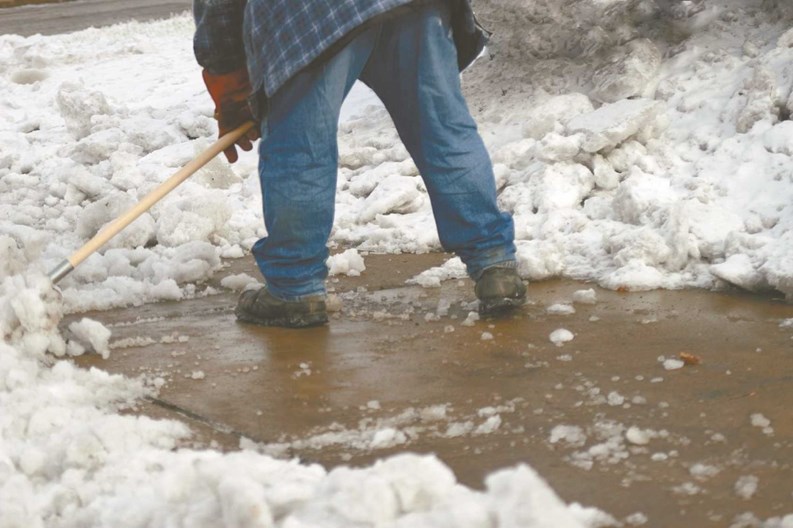No doubt about it, the Big Apple is a pedestrian town: according to the New York City Department of Transportation (DOT), over eight million people tread the city’s approximately 12,750 square miles of sidewalks each day.
New Yorkers are accustomed to traipsing through all types of inclement weather, but during the harsh winter months, making one’s way from Point A to Point B becomes even more of a battle. Winter weather creates hazardous conditions that can be extremely dangerous for both drivers and pedestrians, and while there are city agencies responsible for monitoring and dealing with the icy side effects of freezing temperatures and winter storms on public roadways, taking care of slippery sidewalks is a responsibility that falls more squarely upon the shoulders of civilians—including co-op and condo boards.
The City Side
The DOT is the agency that monitors and controls sidewalk repairs across the five boroughs. In 1992, the DOT created the Office of Sidewalk Management (OSM) to promote the issue of pedestrian safety to educate and inform the public regarding responsibilities and procedures for maintaining sidewalks in safe condition.
The OSM and the City Charter and the New York City Administrative Code categorize city sidewalks into three major groups: City-owned property; one-, two- and three-family owner-occupied properties; and “four-plus,” which includes all multifamily buildings and commercial properties. According to Diane Altieri of the OSM, “The DOT now focuses its maintenance efforts on sidewalks abutting city property, as well as one-, two-, and three-family owner-occupied properties throughout the five boroughs.” For buildings categorized as “four-plus,” the property owner is responsible for the maintenance and repair of all sidewalks abutting the property.
This specification is fairly recent. According to Robert J. Braverman, a managing partner with the law firm of Braverman & Associates, PC in Manhattan, “Up until a few years ago, the city was responsible for the maintenance and repair of sidewalks. However, the law was changed [in 2002], and now unless the building is a one- to three-family residence—which would exclude almost all co-ops and condominiums—the property owner bears the responsibility” for maintaining those sidewalks.”
In the case of co-ops and condos, the “property owner” means the co-op corporation or condo association. The responsibility for sidewalk maintenance does not vary between co-ops, condos, or rentals. “The type of building is irrelevant, if it contains four or more units or is a commercial property,” says Braverman. “The property owner is responsible for the abutting sidewalk.”
The “Civilian” Side
So with that responsibility, what liability does a building bear for accidents that might happen as a result of their sidewalk disrepair? That can be a complex question. First of all, what constitutes disrepair? According to Altieri, it ranges from things like collapsed pavement and trip hazards—which can include hardware or tree roots—to improper slope and patchwork, and failure to clear snow and ice promptly.
“A building is also liable if it fails to remove snow or ice within a reasonable time after a storm ends,” says Braverman, bringing up something of a gray area when it comes to defining a building’s liability and protecting property owners from costly lawsuits and increased insurance costs.
“What constitutes ‘reasonable time’ depends on numerous factors, including but not limited to the severity of the storm, the amount of precipitation involved, the amount of accumulation, the temperature, and winds causing drifting,” explains Jon Kolbrener, another partner with Braverman’s firm. “The City Administrative Code provides that snow must be removed within four hours of the time it stops falling—excluding the hours between 9 p.m. and 7 a.m. The [Administrative Code] also provides that snow and ice that are frozen so hard they cannot be removed are to be treated with ashes, sand, sawdust or some similar material until it is possible to thoroughly clean them.”
Kolbrener points out that there are also variances within the city’s administrative code according to borough, which also factor into how vulnerable a building may be to a sidewalk-related lawsuit. But as a rule, he strongly advises boards and managers to heed the law, and “make sure that the sidewalks adjacent to their property are cleared within four hours of the time the snowstorm ends.” This rule applies for any type of frozen precipitation, and might mean several rounds of clearing snow and deicing pavement, especially if the storm is particularly persistent.
Protection & Preparation
There are several steps that boards and property managers can take to protect themselves from costly sidewalk-related lawsuits. The pros agree that the key—as with so many building-related issues—is preparedness, which in the case of sidewalk maintenance starts long before any snowflakes ever think about falling.
“It’s imperative that during the summer, all buildings have their staff check their sidewalks for cracks, holes and separations that could cause tripping” and repair them, says Steven Gold, president of Manhattan-based management and brokerage company Hudson View Associates. He also recommends using the warm months of the year to fix or replace snow removal equipment such as snow blowers, icebreakers, salt spreaders and shovels. It’s also easier and cheaper to stock up on calcium chloride in August, when demand—and prices—are lower.
Being prepared includes keeping an eye on weather reports for impending storms, as well as making sure that adequate maintenance staff is not only on duty, but aware of the building’s obligation to maintain a safe and clear walkway within a reasonable amount of time.
“If it’s going to be a nasty one,” says one Queens superintendent, “we get the supplies out ahead of it—the shovels and the calcium chloride. As soon as we get the weather forecast, the bags of snow-melt go in the service hall and are there for us when we need them.”
The process of cleaning up winter sidewalks should begin during a storm, not after, as it’s far easier to keep walkways clear in stages than it is to try and tackle them as one big job. According to Gold, the worst type of weather for building staff to deal with is snow and ice together. When precipitation is mixed and accumulating by the minute, it’s important for building staff to get and stay on top of salting and shoveling so that the ice doesn’t have a chance to take over the sidewalk.
“If you don’t have [staff] clean up the snow within the first hour-and-a-half of the storm, they won’t be able to clean it up later,” says Gold. “The most important thing is to clear the sidewalk down to the concrete to prevent the ice from forming.” Gold says it also helps to shovel the entire sidewalk free of snow from the building to the street. A narrow footpath will likely melt during the day, then freeze over during the colder nighttime hours, then melt and refreeze again into a rock-hard coating of ice.
Being proactive when it comes to sidewalk care—both during snowy weather and the off-season—ensures that the threat posed by ice and and snow is removed at the earliest possible time. And that not only reduces the likelihood that someone will fall, but lessens the chances of the building being accused of negligence.
Other Options
Some buildings may choose to use an independent contractor instead of in-house staff for snow and ice removal—in that case, there are other important contractual measures to be considered for the building’s protection.
“It’s essential that the written agreement has an indemnity/hold harmless clause running in favor of the building owner,” Kolbrener stresses, “[as well as an] insurance procurement agreement, which obligates the snow removal company to obtain insurance naming the building owner as an additional named insured.”
In addition to those specifications, adds Kolbrener, “A copy of the insurance policy should be produced—not just a Certificate of Insurance. Courts have repeatedly held that a Certificate of Insurance is not evidence of insurance.”
It’s also imperative that sidewalk conditions are not worsened by carelessness during their upkeep. Snow should be piled curbside in the least precarious way, and building staff must keep in mind that melting snow can create serious liabilities for a building in the form of sheet ice. As Kolbrener points out, “Ice comes as a result of runoff from gutter spouts, or due to melting snow piled adjacent to the sidewalk,” and like snow, it must be dealt with as quickly as possible, with salt, sand, or commercial deicing product.
While the city of New York does not generally enforce sidewalk safety maintenance rules, it is important to remember that the cost of a private lawsuit can cripple even a financially-robust building. It is crucial then, that your building make sidewalk safety a priority to keep itself protected from the unnecessary costs of slip-and-fall lawsuits. This process is a simple combination of common sense and proactive maintenance that will ultimately reduce the likelihood of slip-and-fall injuries and the lawsuits they so often bring with them.
For more information on sidewalk and roadway maintenance, visit the New York City Department of Transportation’s website at http://www.nyc .gov/dot.
Kathleen J. Blank is a freelance writer and publisher’s assistant for The Cooperator.







Leave a Comment